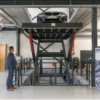Selecting the right elevator for your commercial building is a critical decision that affects both the functionality and efficiency of the building. The right choice enhances operational efficiency, supports accessibility, and ensures the safety and comfort of users. This guide will help you navigate the process of choosing the ideal elevator by highlighting key factors and considerations to ensure you make an informed decision.
1. Assess Your Building’s Needs
1.1 Building Size and Type:
- Building Size: Consider the height and footprint of your building. High-rise buildings typically require high-speed elevators with advanced control systems, while mid-rise and low-rise buildings may have different needs.
- Building Type: The elevator requirements for a hotel, office building, or retail space can differ. Evaluate how the elevator will be used and the specific needs of your building’s occupants.
1.2 Traffic Patterns:
- Usage Frequency: Analyze the expected number of passengers and the frequency of elevator use. Buildings with high foot traffic may need elevators with higher capacities and faster speeds to accommodate peak periods efficiently.
- Traffic Analysis: Conduct a traffic analysis to determine the appropriate elevator capacity, speed, and number of units required to meet demand.
2. Determine Elevator Specifications
2.1 Load Capacity:
- Weight Limits: Choose an elevator with an appropriate load capacity based on the typical weight and number of passengers. Commercial elevators generally have higher load capacities compared to residential models.
- Future Needs: Consider potential future changes in building use that might impact load requirements, and opt for a capacity that can accommodate growth.
2.2 Speed and Performance:
- Travel Speed: Select an elevator with a travel speed that matches the height of your building and the expected wait times. High-rise buildings require faster elevators to minimize travel times.
- Performance Metrics: Look for elevators with reliable performance metrics, including smooth operation, minimal vibration, and noise reduction.
2.3 Design and Aesthetics:
- Cab Design: Choose a design that complements the building’s interior and meets aesthetic preferences. Customizable interiors can enhance the visual appeal of your elevator while aligning with the overall building design.
- Material Options: Select materials and finishes that are durable and easy to maintain, while also considering how they contribute to the building’s aesthetic.
3. Consider Energy Efficiency and Sustainability
3.1 Energy-Efficient Features:
- Regenerative Drives: Opt for elevators with regenerative drive systems that recover energy during braking and reduce overall energy consumption.
- LED Lighting: Choose elevators with energy-efficient LED lighting to decrease power usage and lower operational costs.
3.2 Sustainable Practices:
- Eco-Friendly Materials: Look for elevators designed with sustainable materials and components that contribute to green building certifications.
- Compliance with Standards: Ensure the elevator complies with environmental standards and contributes to the building’s sustainability goals.
4. Evaluate Safety and Accessibility
4.1 Safety Features:
- Emergency Systems: Ensure the elevator is equipped with reliable emergency communication systems, including alarms, intercoms, and backup power sources.
- Safety Certifications: Verify that the elevator meets local and international safety standards and regulations.
4.2 Accessibility:
- ADA Compliance: Ensure the elevator meets accessibility standards, such as the Americans with Disabilities Act (ADA) in the U.S. or other local regulations, to accommodate all users.
- User-Friendly Controls: Select elevators with easy-to-use controls and features, such as voice-activated commands or touchless interfaces, to enhance accessibility.
5. Consider Maintenance and Support
5.1 Maintenance Requirements:
- Service Contracts: Choose an elevator with a service contract that includes regular maintenance, inspections, and emergency repairs to ensure reliable operation.
- Warranty: Check the warranty terms and coverage to protect your investment and address potential issues promptly.
5.2 Manufacturer Reputation:
- Reputation and Reliability: Opt for elevators from reputable manufacturers known for their reliability, quality, and customer support.
- Customer Reviews: Research customer reviews and testimonials to gauge the performance and service quality of the elevator and manufacturer.
6. Budget and Cost Considerations
6.1 Initial Costs:
- Installation Costs: Consider the total cost of installation, including the elevator unit, construction modifications, and any additional features or customization.
- Financing Options: Explore financing options if needed, including leasing or purchasing plans, to manage the upfront costs.
6.2 Long-Term Costs:
- Operational Costs: Assess the long-term operational costs, including energy consumption, maintenance, and repairs.
- Return on Investment: Evaluate the potential return on investment by considering how the elevator will enhance building functionality and tenant satisfaction.
Conclusion
Choosing the right elevator for your commercial building involves careful consideration of various factors, including building size, traffic patterns, load capacity, and energy efficiency. By evaluating your building’s specific needs, assessing elevator specifications, and considering safety, accessibility, and budgetary constraints, you can make an informed decision that enhances both functionality and user experience. Investing in the right elevator ensures smooth vertical transportation, supports building operations, and contributes to the overall success of your commercial property.








